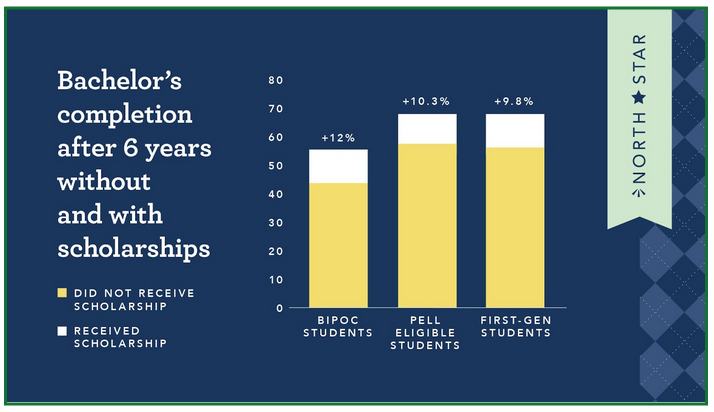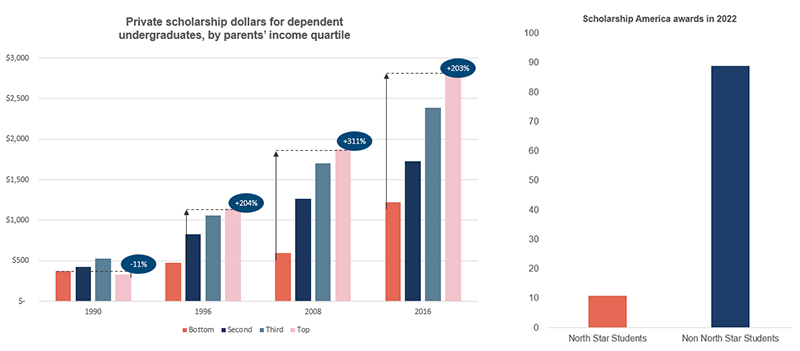Scholarship America reached a proud milestone in 2022: since our founding, we have connected students to $5 billion in scholarships and financial support. But as we look to our future, one thing is clear. As impressive as that dollar amount is, it’s not making the biggest possible impact. Because our work, and our industry, needs to evolve.
The private scholarship industry originated in a higher-education environment that was incredibly homogenous. When Scholarship America was founded in 1958, there were around 3.5 million college students. Two-thirds were male, the vast majority were white, and they largely followed a straight path from high school to a summer job to college. If they got a scholarship, it was in recognition of their achievements, and offered a way to defray some of the average annual college cost of around $1,300.
The founders of those scholarships very likely didn’t think about a world where 17 million people are in college, nearly half of them are nonwhite, and a third are over age 24. They probably didn’t imagine ¾ of college students holding jobs while in school. And they definitely didn’t imagine average costs of attendance ranging from $25,000 to $35,000 per year.
Higher ed has evolved, and a degree or certificate is a more important gateway to the workforce than ever before. Unfortunately, plenty of scholarships are still based on the model that worked for those 1960s students.
That means that the students who stand to benefit the most from scholarships are actually the least likely to receive them. And that led Scholarship America, as the largest scholarship provider in the nation, to develop an ambitious North Star Goal: To award a majority of our scholarships to high-need, historically marginalized students by 2027 so they can realize the benefits of a high-quality college degree or credential.
The Need and the Gap
There’s ample evidence that in today’s America, these students are at a significant disadvantage when it comes to staying in college, working their way to a degree and finding a better job. And there’s also plenty of research showing that they have the most to gain by receiving scholarships and completing their education.
The 2022 data from the National Student Clearing House is a solid benchmark: when it comes to six-year college graduation rates, Black, Latino and Indigenous students are 20-25% less likely to graduate with a Bachelor’s degree than white or Asian students.
Scholarships and other financial supports are a significant factor in closing that gap—and when researchers studied the effectiveness of scholarships, they found the biggest impact on college completion among the students we’ve identified in our North Star Goal. In a 2020 study from Blueprint Labs at MIT, we saw that when BIPOC, low income and first-gen students received financial support, their chances of completing their degree grew by up to 12% compared to students in their cohort who didn’t.

So if we’ve got the tools to remove barriers, and we know which students will benefit the most from those tools, why do we still have a problem?
A Paradigm that Needs to Shift
The problem exists, quite simply, because we’re not getting scholarships to the students who would benefit from them the most. Based on research from financial aid analyst Mark Kantrowitz[CBS1] [MK2] , across the private scholarship industry, the likelihood of being awarded a scholarship drops to 8% or 7% if you’re a Latino, Asian or Black student. And it’s a similar story for first-gen and lower income students – you are less likely to receive a scholarship if you are in any single one of these categories.
What’s more, the gap between the wealthiest families and the lowest-income families is continuing to grow. Students in the top income quartile, who have the least need for financial support to attend college, are getting 2.3 times more scholarship funds than students with the biggest financial gap.

As an organization, Scholarship America faces a similar reality. In the last year, only about 11% of our scholarships went to the students identified in our North Star Goal—the students whose college trajectory would be most impacted by whether or not they received a scholarship. Instead, our scholarships, like most of those across the industry, have overwhelmingly been awarded to those who are likely to graduate with or without our support.
Partnering for Solutions
Solving that gap is why we’re so focused on our North Star Goal—a goal created in conversation with Scholarship America’s partners. In addition to the national data and our internal research, partner feedback has told us very clearly that we can make a bigger impact on students, on communities, and on the workforce if we focus on those that have the greatest financial barriers to education.
To do so, we need to think big, but we also need to work with those partners who know their communities best—whether the community they serve is within a company or city, or whether it’s united by demographic or income or future career.
Achieving our North Star Goal and transforming our industry won’t happen overnight, and it certainly won’t happen alone. We’re poised to work with current and future partners who care about their communities, who can identify the students whose lives would be changed by a scholarship, and who can work with us to ensure those students aren’t missing out.
By expanding, building and deepening partnerships with forward-thinking organizations, our work toward the North Star Goal will help develop a more equitable education-to career-pathway. The nation is becoming more diverse, and future leaders are emerging from all kinds of circumstances. It’s incredibly important to every sector of the economy that those talented students don’t fall through the cracks—and partnering with Scholarship America on our bold new vision is a way for companies of any size to be part of that effort.
 hbspt.cta.load(241375, ‘5206218a-3776-48cc-b991-87d4ae610058’, {“useNewLoader”:”true”,”region”:”na1″});
hbspt.cta.load(241375, ‘5206218a-3776-48cc-b991-87d4ae610058’, {“useNewLoader”:”true”,”region”:”na1″});
The post Building a More Impactful Future Together appeared first on Scholarship America.
[ad_2]Article link

